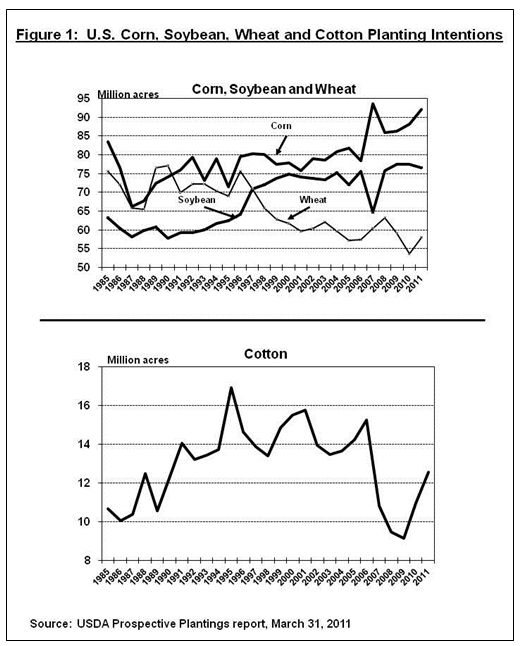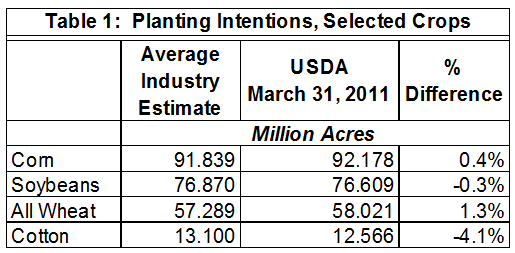Vol. 27, Issue 9, April 1, 2011 – PDF version
Jose G. Peña, Texas AgriLife Extension Economist-Management
The much anticipated U.S. planting intentions report, released on Thursday, March 31, 2011, indicated that compared to last year farmers intend to plant more corn, sorghum, winter wheat, spring wheat, canola, and cotton and fewer acres of oats, rice, soybeans, sunflowers, durum wheat, and dry edible beans (See Figure 1).
While corn and all-wheat plantings were higher than the average industry estimate, soybean and cotton plantings were below the average pre-report industry estimate (See Table 1). The report was generally bullish for grains and cotton and neutral-to-slightly bearish for livestock, as feed costs are likely to increase.
In addition, USDA’s Grain Stocks report, also released on March 31, 2011, showed corn and soybeans stocks down 15% and 2%, very tight supplies that will impact grain markets.
Prices for most agricultural commodities have continued to show strength after the recent weakness which was probably associated with the political unrest in the Middle East, especially in Libya, which is causing crude oil prices to move sharply higher and investors to grow nervous. Very tight U.S. and world supplies and strong U.S. and export demand is fueling the market. The market is providing excellent pricing opportunities for 2011 crops.
Prices for most agricultural commodities improved significantly on the report release day (March 31, 2011). Corn futures prices on the Chicago Board of Trade (CBOT) for 2011 contract deliveries, for example, settled up the 30 cent limit settling at about $6.94/bu. (May 2011 contracts) to $6.26/bu. (December 2011 contracts). Futures prices for 2011 cotton contract-deliveries at the ICE (NYBOT) settled up 6-7 cents per pound, settling at about $2.00/lb (May 2011 contracts) to about $1.32/lb (December 2011 contracts).
July ’11 hard red winter wheat futures contracts on the Kansas City Board of trade (KCBOT) settled at about $9.32/bu. on the report release date, up about 38 cents/bu. from the previous day.
While the planting intentions report indicates that farmers are responding to the significant recent surge in prices, final planting is still a ways into the future for much of the Corn Belt. The situation can and probably will change given the new planting numbers and the extended dry spell in a significant portion of the U.S. southern tier.
Grain production and markets continue to be at a pivotal point in terms of the role of agriculture to help gain energy independence. The Agricultural Outlook Forum 2011 estimate of corn use for ethanol production will account for about 37.2 percent of a potential 2011/12 record corn production crop of 13.428 billion bushels. Corn use for ethanol production will continue as the most significant activity affecting agriculture. .
Corn/Sorghum
USDA’s initial planting intentions report indicated that corn growers intend to plant 92.178 million acres of corn, up 3.986 million acres (4.5%) from 88.192 million planted last year. According to USDA’s planting intention report, if realized, this will be the second highest planted acreage in the U.S. since 1944, behind only the 93.5 million acres planted in 2007. Acreage increases of 250,000 or more are expected in Iowa, Kansas, Nebraska, North Dakota, Ohio, and South Dakota. The largest decrease is expected in Texas, down 150,000 acres.
Using the historical corn acres harvested-to-planted ratio and USDA’s February 25, 2011 Outlook Forum’s 2011/12 corn yield estimate of 161.7 bu./ac., corn production this season could approximate a record 13.428 billion bushels, up 17.9 percent from 12.447 billion bushels produced this past season and up about 2.6 percent from 2009’s record crop of 13.092 billion bushels. Using USDA’s Outlook Forum’s total use estimate of 13.56 billion bushels, demand would exceed production by about 132 million bushels. Ending stocks could drop to about a critical 552 billion bushels, down about 18.1 percent from projected beginning stocks of about 674 million bushels.
The market is expected to remain strong. The situation is going to depend on actual plantings and weather. USDA’s Planting Intentions Report estimate is based on a survey of 85,000 farmers across the country which were asked, during the first two weeks on March, what they intend to plant this year. Figures of actual acres planted will be released during the end of June ’11 and will form a major determinant of this season’s market. The weather and subsequent planting conditions between these two reports will be crucial.
In terms of the current market, grain stocks are down significantly from last year. USDA-NASS, March 31, 2011, Grain Stocks report indicated that corn stocks in all positions as of March 1, 2011 totaled 6.52 billion bushels, down fifteen percent from March 1, 2010.
Sorghum farmers indicated that they intend to plant 5.645 million acres of sorghum, up 241,000 acres (4.5%) from 5.404 million acres planted last year, but down 14.9 percent from 6.633 million acres planted in 2009.
Soybean growers intend to plant an estimated 76.6 million acres, down about 795,000 acres from 77.4 million acres planted last year and down about 842,000 acres from 77.45 million acres planted in 2009.
Cotton
The cotton market has been showing a strong improvement during the past two seasons. But, with about 86 percent of this past season’s production estimate as export bound, the market remains export dependent.
All cotton plantings are expected to total 12.566 million acres (12.313 million upland; 252,000 Pima), up 14.5 percent from 10.973 million acres planted this past season and up 37.3 percent from 9.150 million acres planted in 2009. According to USDA’s March 31, 2011 planting intentions report, cotton acreage increases are expected in every State. The largest increase, at 548,000 acres, is expected in Texas. Acreage increases of more than 100,000 acres are expected in North Carolina, Georgia, and Mississippi.
Using the Agricultural Outlook Forum 2011 historical eleven percent abandonment rate indicated in the February 25, 2011, The U.S. and World Cotton Outlook report and the report’s estimate of expected average yields of 810 lbs/acre, production could approximate 18.87 million bales, up just 3.2 percent from 18.32 million bales produced this past season but up 54.8 percent from 12.19 million bales produced in 2009.
Using the 2011 Agricultural Outlook Forum’s total use projection for 2011/12 of 18.5 million bales, production will exceed the use by about 370,000 bales and would raise the estimate of new crop ending stocks to about 2.88 million bales, up from the March ’11 estimate of this past season’s ending stock of 1.91 million bales.
Sincere appreciation is expressed to Dr. J. Mark Welch, Assistant Professor & Extension Economist-Grain Marketing and Policy for his contribution to and review of this article.



